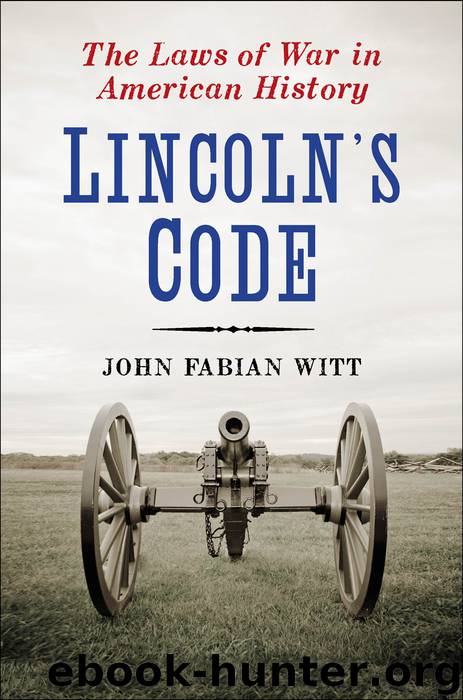Lincoln's Code by John Fabian Witt

Author:John Fabian Witt
Language: eng
Format: epub
Publisher: Free Press
LITTLE IN SHERMAN’S background suggested the unforgiving mode of warfare for which he would become known. A West Point graduate of the class of 1840, where he graduated sixth out of forty-two, Sherman had been brought up in the orthodox world of antebellum military thought. He happily spent much of his early military career stationed in the South and disapproved when his stepbrother Thomas Ewing took up antislavery politics. After a series of failed business enterprises in California and Missouri, he took a job as the superintendent of the Louisiana Military Seminary and settled down comfortably in slaveholding Baton Rouge in 1859 on the very eve of the secession.
Sherman’s initial approach to the conflict closely resembled McClellan’s idea of enlightened warfare. In the Department of the Cumberland in 1861, he punished soldiers for property offenses against noncombatants and provided compensation for property taken by his men. As the historian Charles Royster rightly put it, Sherman’s “standard of conduct was the West Point ideal of a regular army, keeping warfare away from noncombatants for the sake of both humanity and strict discipline.” After the First Battle of Bull Run, Sherman cursed the volunteers: “Goths or Vandals,” he called them, who had no “respect for the lives and property of friends and foes.” He complained that “petty thieving and pillaging” by Union soldiers did the Union cause “infinite harm.” Sherman shared McClellan’s views on slavery as well, instructing his officers that “fugitive slaves must be delivered up on application of their masters.” His thinking reflected Rousseau’s idea that the enemy was an army, not a people.
As the war ground forward, however, Rousseau’s notion no longer appeared to Sherman as a tenable description of the conflict. Serving as the military governor of Memphis in the summer of 1862, Sherman found himself fighting an unending battle not against southern armies but against shadowy guerrillas. The South, he came to see, was sustained not only by its armies but by the farmers who at night turned into fighters, by the newspapers that kept up Confederate morale, and by the women who made sure production on the plantations continued apace in the absence of their husbands. By August, Sherman was becoming convinced that “all in the South are enemies of all in the North,” that the “entire South, man, woman, and child, is against us, armed and determined.” In the war between North and South, he wrote, “all the People of the one” side were “enemies of the other.” Perhaps European wars of the eighteenth century had lived up to Rousseau’s model. But Sherman told Henry Halleck that the Civil War was unlike those conflicts because the United States was “not only fighting hostile armies, but a hostile people.” Sherman laid out the implications: We must, he told Halleck, make not only the “organized armies” of the South but also the “old and young, rich and poor, feel the hard hand of war.”
Once Sherman had come to see the population of the South as his enemy, it was an easy step to adopt a strategy of attacks on civilian infrastructure.
Download
This site does not store any files on its server. We only index and link to content provided by other sites. Please contact the content providers to delete copyright contents if any and email us, we'll remove relevant links or contents immediately.
| Africa | Americas |
| Arctic & Antarctica | Asia |
| Australia & Oceania | Europe |
| Middle East | Russia |
| United States | World |
| Ancient Civilizations | Military |
| Historical Study & Educational Resources |
The Radium Girls by Kate Moore(10905)
The Templars by Dan Jones(4185)
100 Deadly Skills by Clint Emerson(4075)
Rise and Kill First by Ronen Bergman(4012)
The Doomsday Machine by Daniel Ellsberg(3730)
The Rape of Nanking by Iris Chang(3514)
Killing England by Bill O'Reilly(3454)
Hitler in Los Angeles by Steven J. Ross(3435)
Stalin by Stephen Kotkin(3084)
12 Strong by Doug Stanton(3054)
Hitler's Monsters by Eric Kurlander(2730)
Darkest Hour by Anthony McCarten(2643)
Blood and Sand by Alex Von Tunzelmann(2606)
The Art of War Visualized by Jessica Hagy(2412)
Hitler's Flying Saucers: A Guide to German Flying Discs of the Second World War by Stevens Henry(2291)
The Code Book by Simon Singh(2208)
The Second World Wars by Victor Davis Hanson(2132)
Babylon's Ark by Lawrence Anthony(2068)
Tobruk by Peter Fitzsimons(2059)
